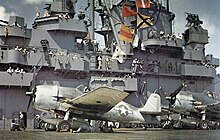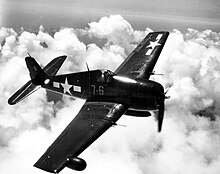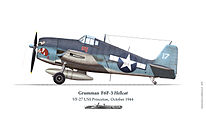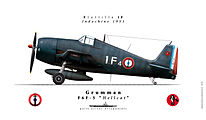Grumman F6F
| Grumman F6F Hellcat | |
|---|---|
 Two US Navy F6F-3s, 1943 |
|
| Type: | Fighter plane |
| Design country: | |
| Manufacturer: | |
| First flight: |
June 26, 1942 |
| Commissioning: |
1943 |
| Production time: |
1942 to 1945 |
| Number of pieces: |
12,275 |
The Grumman F6F Hellcat was an American carrier-based fighter aircraft of World War II . It was the successor to the Grumman F4F Wildcat .
history
The US Navy ordered the XF6F-1 on June 30, 1941 as a potential successor to the F4F, which at that time was the backbone of the carrier-based fighter units. But after the first flight in June 1942, based on the experience in the aerial battles with the Japanese Mitsubishi A6M , it turned out that a large number of improvements were necessary. These flowed into the second prototype with the designation XF6F-3. The XF6F-2 was a planned version with a supercharged Wright R-2600 radial engine , while for the first prototype this engine was used without an exhaust gas turbocharger.
Test pilot R. Hall flew the XF6F-3 (serial number 02982) for the first time on July 30, 1942 with a Pratt & Whitney R-2800 -10 double-wasp engine. The rapid start of series production meant that the first F6F-3 (serial number 04775) was already delivered on October 4, 1942 and from January 1943 could be sent to the first task forces (VF-9 on the USS Essex ). The prototype still had a Curtiss propeller with a large spinner. A standard Hamilton propeller was used in series production .

In contrast to the Grumman F4F Wildcat, the aircraft was designed as a low- wing aircraft . Thus the main landing gear could be moved from the fuselage to the wings. This created a chassis that is much more directionally stable.
Although larger and heavier than the Wildcat , the model showed considerably better flight performance. With this model, the Americans finally won air supremacy in the Pacific . Of the 6,477 confirmed aerial victories of the US Navy, the F6F Hellcat 4947 won. The Fleet Air Arm also used the pattern (first under the name Gannet ). As a night fighter, the Hellcat was equipped with a wing-mounted radar ; for ship combat and ground combat support with missiles.
The F6F-3 was the first main production version with 4,402 units built. The F6F-5 followed with small improvements and 6,681 copies as the second main series. The last major series was the F6F-5N as a night fighter. Production at Grumman ended after 12,272 copies in November 1945. The Hellcat was the first aircraft of the Navy aerobatic team Blue Angels for a few weeks in 1946 .
The F6F-5N was the last to be used in the squadrons until 1953, the F6F-5 flew in training sessions until 1956. F6F-5K target aircraft were used until 1961 and also flew the last combat mission of a US Hellcat when they were from August 1952 in the Korean war from the aircraft carrier USS Boxer was used from as missiles against targets in North Korea. AD-2D Skyraiders served as guided aircraft . Six sorties have been flown with moderate success.
In addition to Great Britain , which received 1177 F6Fs in World War II, ten F6F-5s were delivered to Argentina in 1947 . Argentina later gave some of these machines to Paraguay . Uruguay received twelve F6F-5s. The last South American Hellcats flew in 1961. France received 179 F6F-5 and F6F-5N in 1949, which were used by naval aviators in the Indochina War.
variants

- XF6F-1
- Prototype with Wright R-2600 -10 Cyclone 14 (1268 kW), one built.
- FV-1
- planned but not built F6F-1 by Canadian Vickers.
- XF6F-2
- Version with R-2600-16, not built
- XF6F-3
- Prototype with Pratt & Whitney R-2800 -10W Double Wasp (1491 kW), one built.
- F6F-3
- Production version, 4402 built.
- F6F-3E
- 18 F6F-3s converted to night fighter with APS-4 radar on the outside of the right wing.
- F6F-3K
- F6F-3 converted into a target missile.
- F6F-3N
- 150 F6F-3 converted into a night fighter with APS-6 radar on the outside of the right wing.
- F6F-3P
- some F6F-3 converted to reconnaissance aircraft.
- XF6F-4
- Prototype with Pratt & Whitney R-2800-27 (1555 kW), one built.
- F6F-5
- Series version with a more aerodynamic hood and pulpit. The armament was reinforced by six 127 mm rockets and two under wing stations for one 454 kg bomb each, some were armed with two 20 mm cannons and four 12.7 mm machine guns, 6681 built.
- F6F-5D
- F6F-5 converted into a drone control aircraft.
- F6F-5K
- F6F-5 converted into a target missile.
- F6F-5N
- Night fighter version of the F6F-5 with APS-6 radar on the outside of the right wing, built in 1189.
- F6F-5P
- some F6F-5 converted to reconnaissance aircraft.
- XF6F-6
- Prototype with 2,100 hp R-2800-18W Double Wasp, two built.
- Hellcat I.
- Designation for 252 F6F-3s given to the Royal Navy under the Lending and Lease Act .
- Hellcat II
- Designation for 849 F6F-5 delivered to the Royal Navy.
- Hellcat FR.II
- Hellcat II converted into an armed reconnaissance aircraft.
- Hellcat NF.II
- Designation for 76 F6F-5N delivered to the Royal Navy.
- Hellcat PR.II
- Hellcat II converted to an unarmed reconnaissance aircraft.
production
Acceptance of the Grumman Hellcat by the US Navy:
| version | 1942 | 1943 | 1944 | 1945 | TOTAL |
|---|---|---|---|---|---|
| XF6F-1 | 1 | 1 | |||
| XF6F-3 | 1 | 1 | |||
| F6F-3 | 10 | 2,545 | 1,847 | 4,402 | |
| F6F-5 | 4,291 | 3,577 | 7,868 | ||
| TOTAL | 12 | 2,545 | 6.140 | 3,577 | 12,274 |
Military users
Technical specifications
| Parameter | F6F-3 data | F6F-5 data |
|---|---|---|
| crew | 1 | |
| length | 10.10 m | 10.23 m |
| span | 13.05 m | 13.08 m |
| height | 3.97 m | 3.99 m |
| Wing area | 31.03 m² | |
| Empty mass | 4100 kg | 4,152 kg |
| Takeoff mass | 5160 kg | 6,991 kg |
| drive | an 18-cylinder double radial engine Pratt & Whitney R-2800 -10W Double Wasp with 2,000 PS (approx. 1,470 kW) | |
| Top speed | 612 km / h at an altitude of 5280 m | 621 km / h |
| Service ceiling | 11,720 m | 11,369 m |
| normal range | 1745 km | 1674 km |
| Armament | six 12.7 mm guns | six 12.7 mm machine guns with 400 rounds each, two bombs or six rockets (max. 907 kg) |
Web links
Individual evidence
- ^ William Green: War Planes of the Second World War. 3rd edition, 1965
- ↑ Squadron Signal Aircraft in Action 1036 F6F Hellcat
- ^ Richard S. Then: Walk Around - F6F Hellcat. , Walk Around Number 9, squadron / signal publications, 1996, p. 55
- ^ René J. Francillon: Grumman Aircraft Since 1929. London 1989, p. 194 ff .; Statistical Digest of the USAF 1946, p. 100 ff.









